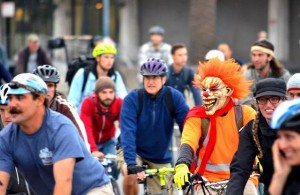2012: Bicyclists still want improvements to city streets, particularly Market Street. Pavement is taken for granted, but bicyclists are still getting their wheels caught in streetcar tracks, sometimes with deadly results. The San Francisco Bicycle Coalition advocates a separate path for bicycles, physically separated from motor vehicles.
Participants
1896: Wheelmen and wheelwomen came from all over the Bay Area, many of them members of bicycle clubs, such as The Bay City Wheelmen and the YMCA Cyclers. The umbrella organization nationwide was the well-organized League of American Wheelmen.
2012: Bicyclists came from all over the Bay Area. Though Critical Mass has no official leader, it does have a website. Organizations like the San Francisco Bicycle Coalition have helped represent concerns of cyclists to the city government.
Atmosphere
1896: Drawing on archival newspaper reports, Chapot described the crowd this way:
A few men rode in drag, one “in the togs of a Midway Plaisance maiden,” another as an old maid. Uncle Sam rode in bloomers next to a down-home hayseed.There were meaner
stereotypes: Sitting Bull and Pocahontas; a man in bloomers mocking “the new women;” one in blackface; one “imitating a Chinese in silks and slippers.”
There were also a good number of women, in bloomers, defying the dress code of the day. The parade ended in rallies with bonfires and political speeches.
2012: Friday night's ride included at least one naked man, masks, face paint, trailers, double bikes welded on top of each other and many other colorful costumes.
Conflict
1896: The big enemy in those days were the streetcars. The crowd threw blocks of wood at streetcars trapped in the mass of riders, smashing their windows, and rocked the vehicles back and forth trying to overturn them.
2012: Riders gleefully snarled traffic downtown for several hours. Still, the atmosphere remained calm compared to some of the monthly Critical Mass rides of the 1990s, particularly 1997 when cyclists were accused of denting, scratching and smashing the windows of various motorized vehicles, and motorists were accused of intentionally running into riders.
Impact
1896: Market Street, and the rest of San Francisco, eventually got asphalt, literally paving the way for the motor vehicles that have since become bicyclists primary competitors for space on the streets.
2012: Bicycle activists are still arguing about the role that Critical Mass has played in getting more bike lanes and other bike-friendly additions to San Francisco streets. The ride on Friday was mostly commemorative, but it generated a lot of enthusiasm for renewed activism.

